Panama City has an important location on the narrow isthmus between Central and South America. Its position is strongly linked to both its history and its modern-day prosperity. Panama City today is modern and stylish, but with a slow-paced Central American vibe.
Casco Viejo
Panama’s Old City, Casco Viejo, was actually the second Spanish settlement in Panama City. The original Spanish colonial town, built in the 1500s, was burned down during an attack by renowned pirate, Captain Morgan. Casco Viejo was established 12 km away on a small cape in 1673. Casco Viejo is therefore around 150 years younger than first settlement in Panama and 100 years younger than nearby Cartagena, Colombia. The difference between Cartagena and Casco Viejo today is that Panama’s Old Town has only been partially restored. Although our pictures don’t show it, about half of the buildings in Casco Viejo are either under restoration or require restoration. The ones that have been renovated though are in fabulous shape. Their pastel painted walls, pretty balconies and decorated windows are a reminder of what this town looked like 250 years ago.

Casco Viejo, Panama 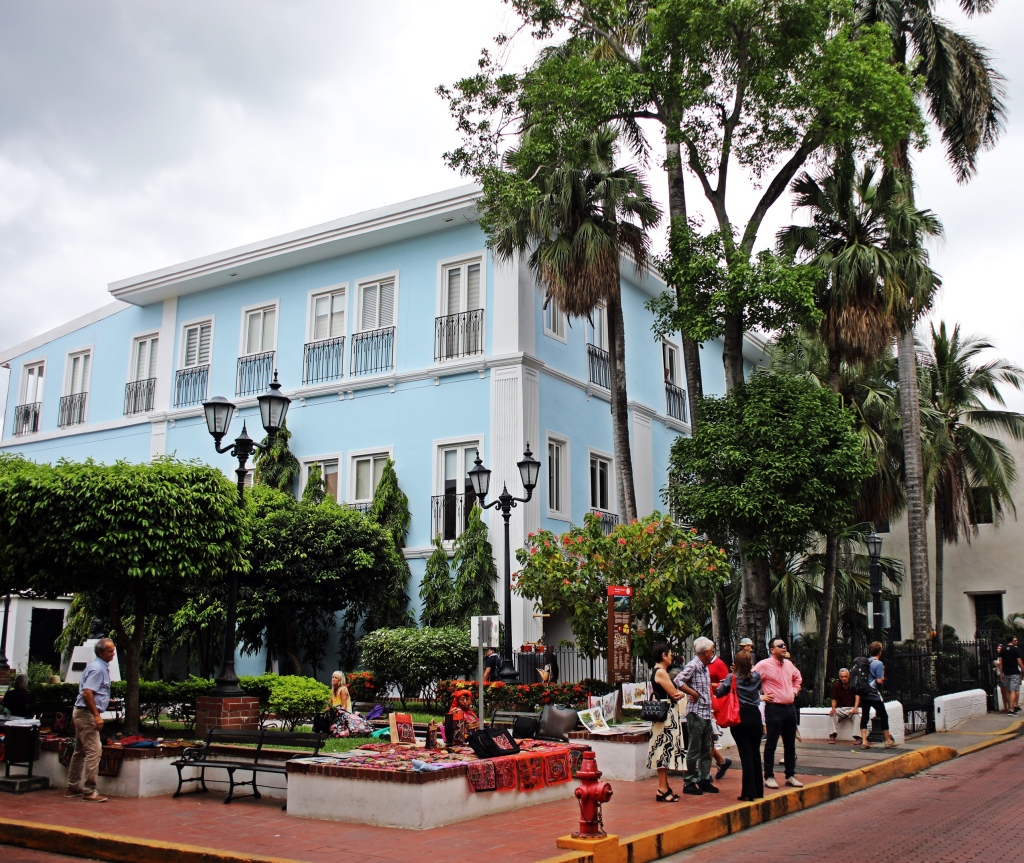
Casco Viejo, Panama 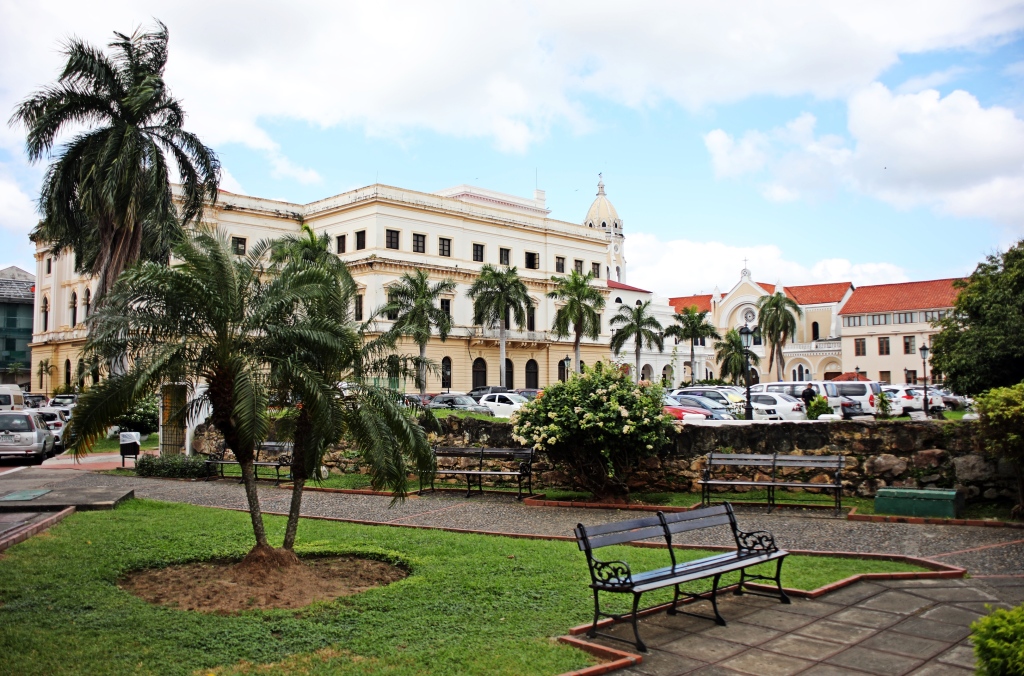
Casco Viejo, Panama 
Plaza de la Catedral , Casco Viejo 
Refurbished and decaying buildings, Casco Viejo, Panama 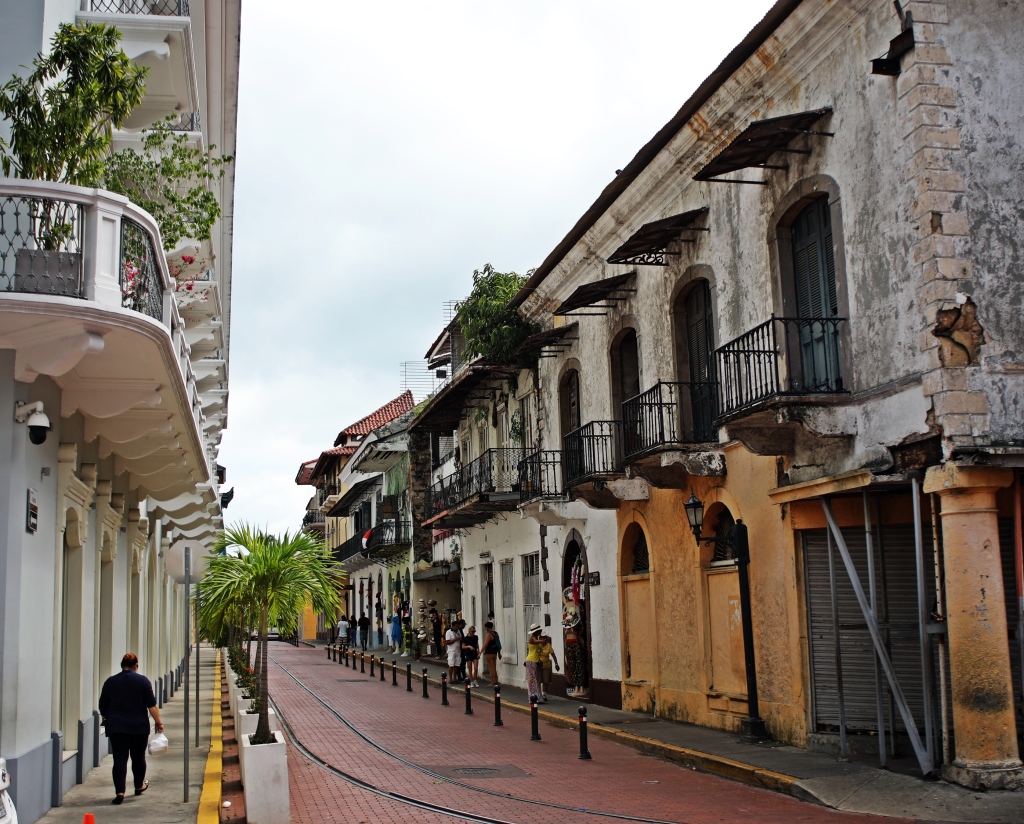
Non-restored buildings, Casco Viejo, Panama 
Tourist Police vehicle, Casco Viejo, Panama
The large churches in Casco Viejo are beautiful stone buildings with ornate interiors. The glittery golden alter at the front of Iglesia de San Jose has an interesting history. The legend says that when Panama City was under attack by Captain Morgan, a priest hid mounds of gold in the Pacific Ocean. Only when Captain Morgan left, was the priest able to retrieve the gold. He used this gold to create an ornate alter in the new church in Casco Viejo.

Catedral de Panama, Casco Viejo 
Catedral de Panama, Casco Viejo 
Iglesia de San Jose, Casco Viejo, Panama 
Arco Chato Church ruins, Casco Viejo, Panama
Panama is a very modern city located on the Bay of Panama in the Pacific Ocean. Many of its tall skyscrapers have ultramodern designs that add interest to the downtown area. There is a lovely park with a walking path along the Pacific shore. From here if you look toward the city you see the tall skyline of these modern buildings in front of the ocean. One direction faces the modern city, but round the corner and you see the old colonial buildings of Casco Viejo. It’s an interesting contrast.

Interesting architecture, Panama City 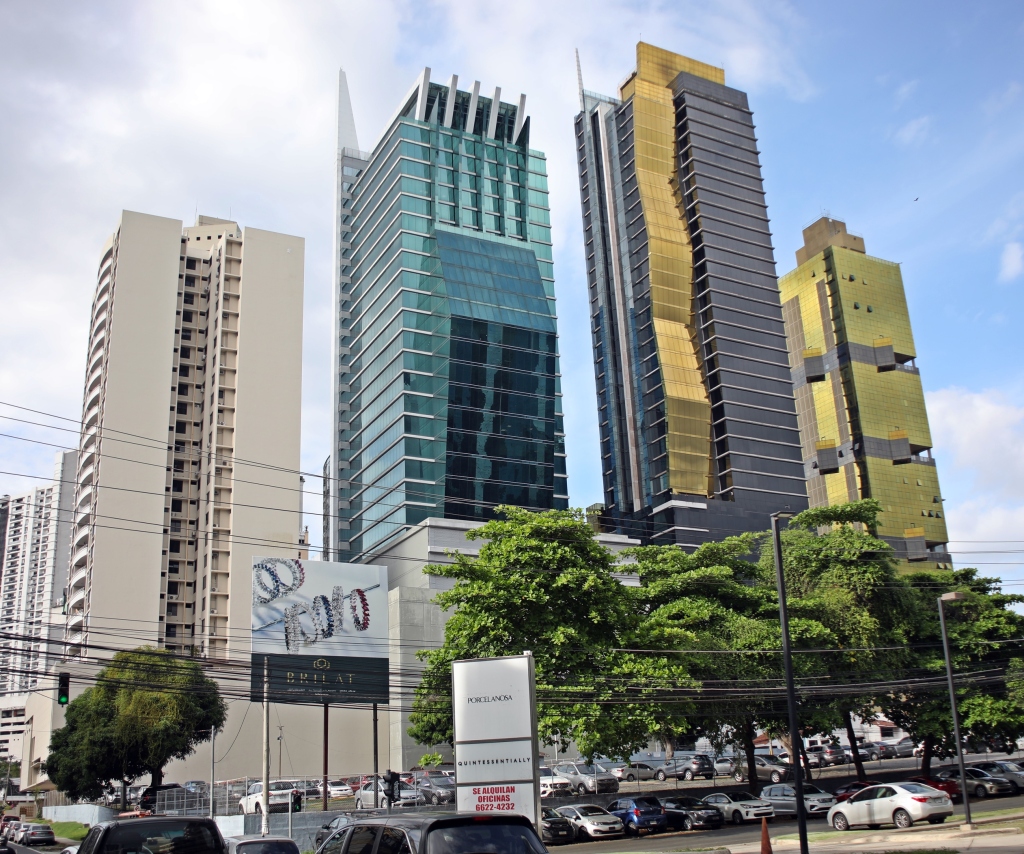
Interesting architecture, Panama City 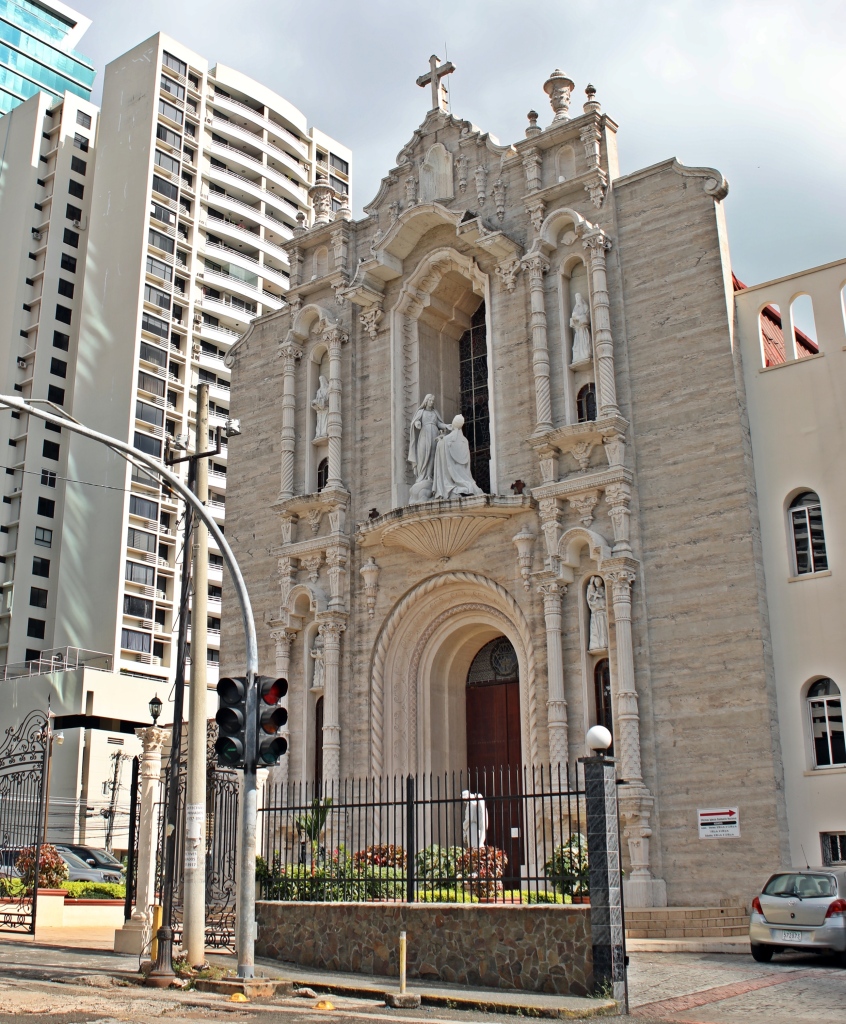
Colonial Church, Panama City 
Panama City 
Panama City skyline 
Panama City Skyline 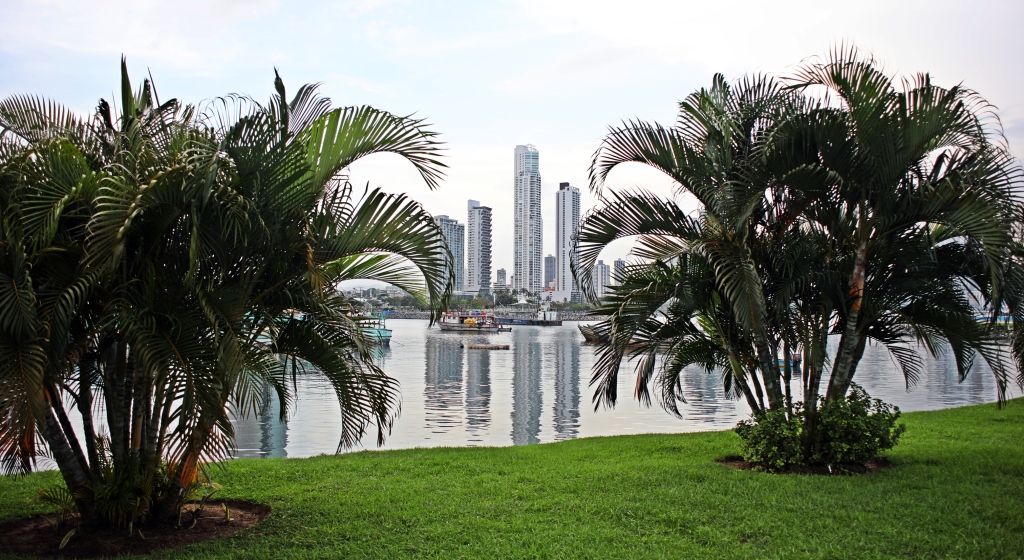
Panama City Skyline 
Casco Viejo and harbour at high tide
The tides are very dramatic in Panama City. It’s interesting to see the city from the same spot during both low and high tides to see the striking difference. Fishing boats go from resting on the muddy beaches to floating in the deep harbour waters.

Panama City and harbour at low tide 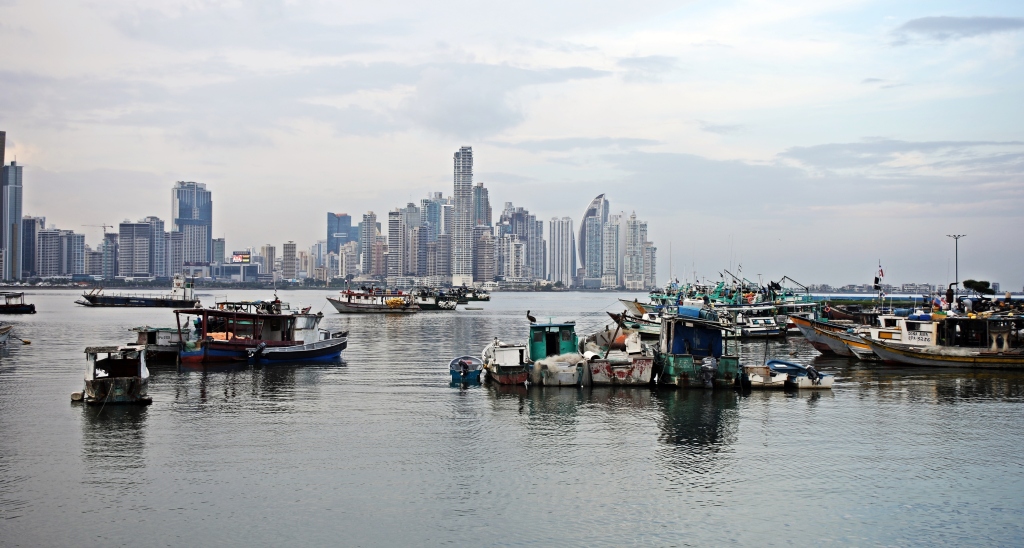
Panama City and harbour at high tide 
Panama harbour at low tide 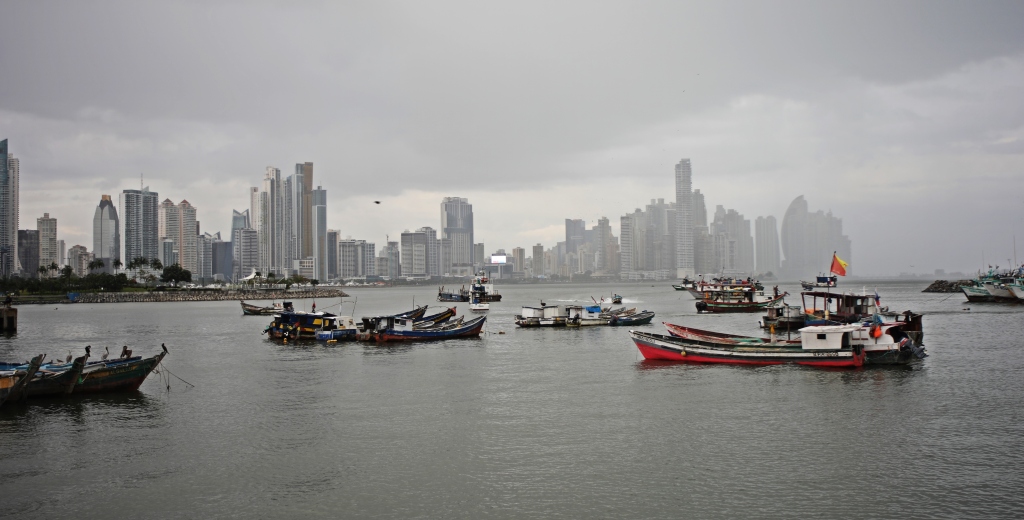
Panama City at high tide 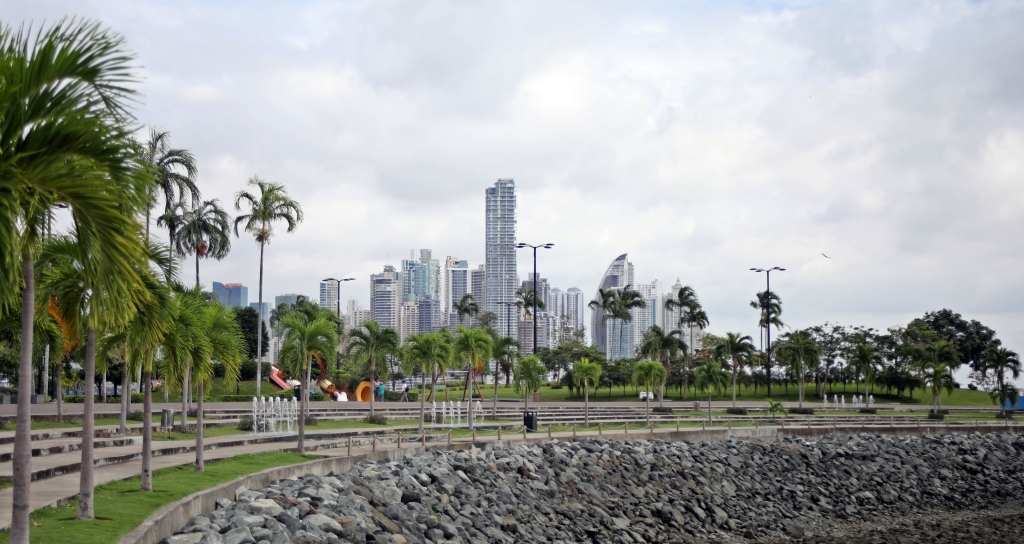
Panama City at low tide 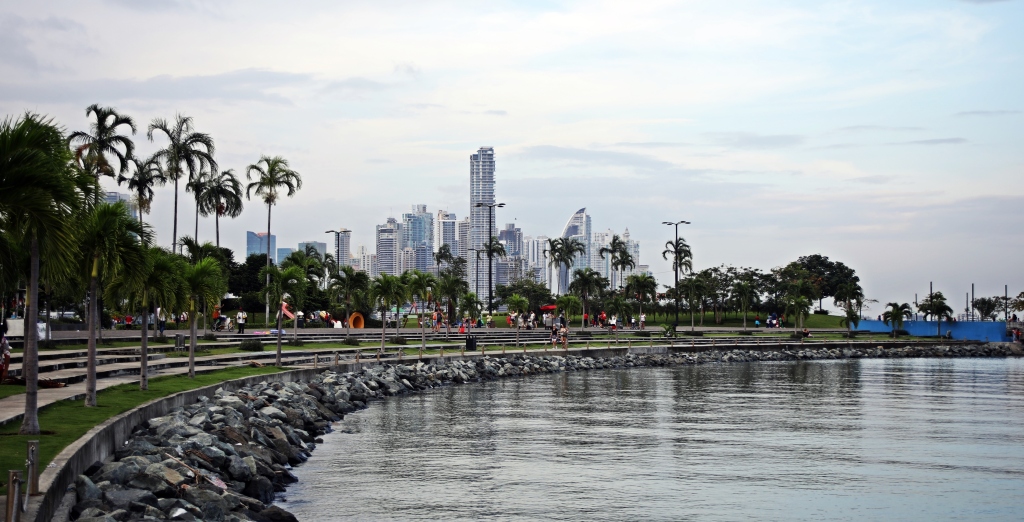
Panama City at high tide 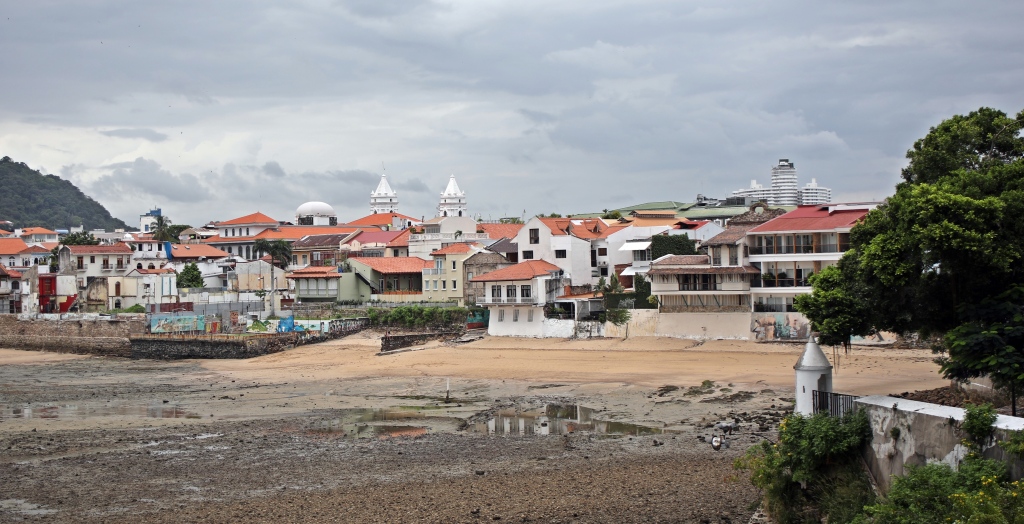
Casco Viejo at low tide, Panama 
Casco Viejo at high tide, Panama
The Panama Canal
One of the most famous landmarks in Panama is the canal. We thought it would simply be a few boats going down a canal. Actually, that’s all it is, but it was one of the most fascinating places we visited. The canal allows boats to cross Central America from the Pacific Ocean to the Caribbean Sea and vice versa. The passage involved 3 sets of locks, several artificial lakes and is spread over 80 km (50 miles). We went to Miraflores Locks where there are two stages spread over 1.7 km and an elevation difference of 16m (54ft) from one end to the other. It was very impressive watching the large cargo ships be skillfully led into narrow channels by 4 small locomotives and stop under control just behind small sailboats and ferries.

Sailboats and large ship with highest water level, Panama Canal 
Ship entering lock, Panama Canal 
Locomotive pulling a large ship, Panama Canal
To make up for the 16 m difference in height from one side of the locks to the other, the water level in each stage is either raised or lowered to match the level of the next stage. As soon as all boats were inside the stage, the large gates opened and water poured out. We watched as the boats slowly disappeared, as if they were sinking, as their water levels lowered. Then the locks opened, and all we saw was the tips of the boats pass by. In the next stage, they are at the same height as the water in the bay. It doesn’t seem unusual until you look back and see the water level in the first stage.

Water level at lowest level in far canal, Panama Canal 
Ships in different water levels, Panama Canal 
Water level decreasing, Panama Canal 
Ships going through the locks, Panama Canal
Once through the lock, the gates closed and water bubbled up, refilling the canal for the next boats in line. The locks operate in one direction for half of the day, and then in the other direction for the other half. It was fascinating to see the water level differences between the inside and outside of the locks. As well as the difference between the two canals in front of us since they were at different stages of letting boats pass through.
We met a man who used to work at the canal. He told us there is a tunnel underneath the canals so workers can get from one side to the other. He also said that his job was to clean out the large filters at the bottom of the canal. Sometimes large fish get caught in the filters and die in the canal.
Coronado
An hour outside of Panama is the ex-pat community of Coronado. We wanted to check out this neighbourhood to see what ex-pat living entails. We knew it was a gated community, but we expected to find a community with restaurants and convenience stores. Instead what we found was long streets with tall walls and gates preventing anyone from seeing in. We were able to get access to the beach so we did have a better look at the area. From the beach we could see many tall condo buildings and large private beach homes. There were wonderful views along the coast, but it didn’t have a community feel. We’ll have to keep looking.

Coronado Beach, Panama 
Coronado Beach, Panama 
Coronado beach homes, Panama
Tips for visiting Miraflores Locks at the Panama Canal
Miraflores Locks are the closest locks to Panama City so are very popular but offer a great view of the locks in action.
Getting to Miraflores Locks
By bus – Take the metro to Albrook Mall, then cross the shopping mall to the bus terminal. Catch the bus with a sign for ‘Miraflores’. They let you off at the front door of the observatory. Do the reverse to return to the city.
By taxi – From Casco Viejo a taxi will cost $5 USD for a one-way trip. You will spend at least one hour, so don’t have the taxi wait. There are many taxis available to take you back.
Tours – There are many tours offered in the city, but you don’t need a tour, it’s very easy to do on your own.
Hours
Miraflores Locks are open every day from 8 am – 6 pm. Tickets are sold until 5:15 pm. The boats go one way in the morning and the opposite in the afternoon. On most days there are no boats in the locks between approximately 10 am and 2 pm because they are switching the locks from one direction to the other. This time will vary a little each day. We arrived at 1:45 and had to stand in a long line to purchase tickets. By the time we got to the front of the line and bought our tickets, the four floors of Miraflores were crowded. We thought we wouldn’t see anything, but after the first boats went through (1 hour), most people left. We had a perfect view of the second boats, so it actually helped us to wait in line. Either arrive very early, or arrive 45 – 60 minutes after the first boat is scheduled. That way the tour buses have left and crowds are thinner.
Coming Next: Finding Paradise in San Blas Islands
For extra pictures from Panama click here. From pictures from our other blogs go to Gallery at monkeystale.ca
To read about more of our adventures go to Destinations.
If you like what you read, please comment or share (with credit) using the links below.
O wow! The best part is watching the ships passing through the Panama Canal. Incredible technology and amazing experience for yours.
LikeLiked by 2 people
I know I was surprised how much I liked it, but it’s very impressive. Thanks for reading!
LikeLiked by 2 people
Another great post!!! Thanks for some great images too!
LikeLiked by 2 people
Thank you!
LikeLiked by 1 person
Great post !
LikeLiked by 2 people
Thank you !
LikeLike
For some reason I don’t see that many blog posts about Panama City in the blogging world, so this one gives a really fresh perspective on a part of the world I rarely read about. That swirling skyscraper truly is a head-turner! I love to see sections of the Panama Canal — such a great engineering marvel of the modern world!
LikeLiked by 2 people
Thanks Bama, we were very impressed with Panama City and especially the canal. We’ll have 2 more posts about other places in Panama coming up. Thanks for reading!
LikeLiked by 1 person
Fantastic photos! Panama looks amazing and I never really considered visiting! My husband’s cousin lives and works in Panama city, so we might as well go visit him and have someone show us around! Thanks for sharing and safe travels 😀 Aiva
LikeLiked by 2 people
Thanks Aiva, we didn’t really know what to expect in Panama, but were very impressed. It’s modern, organized with a good Metro system. It’s also very safe, at least as safe as a large city anywhere. You should definitely take advantage of having family there. He would probabaly take you to the quieter Canal viewing area. Don’t have high expectations for Casco Viejo. It’s nice, but still under renovations. Maggie
LikeLiked by 1 person
Any idea why so many shiny buildings in Panama City?
LikeLiked by 2 people
I think because with the Panama Canal, a lot of wealth came to the city and it grew very quickly. I’m not sure why they used such unusual designs though.
LikeLike
Ok. Thanks for sharing your thoughts. 😊
LikeLike
Nice post
LikeLiked by 2 people
Thank you!
LikeLike
Now I know more about Captain Morgan than just the rum! Interesting history. I didn’t know that Panama is such a modern city. The contrast to the old city is amazing. I have been fascinated by much smaller canals/locks so I’m sure visiting the mother of all canals would be an amazing experience.
LikeLiked by 1 person
We didn’t do much research for this trip and were very surprised with Panama City! The architecture is so interesting from old to ultramodern. The canal was one of my favourite parts. I knew the concept but to see it in action was fascinating. And the huge ships going at the same time as small sailboats was also unexpected and very interesting.
LikeLiked by 1 person
Nice post. Loved the pics. Took me back to when I visited in 1977 🙂
LikeLiked by 1 person
Thanks! I bet it was different in the 70s though!
LikeLiked by 1 person
Such a lovely city!!
🙂
LikeLiked by 2 people
Panama is a great city. We didn’t know what to expect, but we really enjoyed it.
LikeLiked by 1 person
Impressive tides. Nice idea to take low and high tide photos for comparison.
The Cetadral is striking, with the bare stone facade stuck between two stucco covered towers.
LikeLiked by 2 people
At first we thought it had the ugliest coastline until we came back later when the tide came in. It makes such a difference in the city’s appearance.
LikeLiked by 1 person
I love the comparison between the old and the new! The old city looks so charming, and the “new” city looks way more modern than I expected Panama City to look!
LikeLiked by 2 people
Thank you! Yes the ultra modern skyscrapers were a surprise to us too and completely opposite to the old town area.
LikeLike
Panama looks much different than I pictured! Nice post and great photos!!
LikeLiked by 2 people
I know, we didn’t know what to expect from Panama, but we really liked it.
LikeLiked by 1 person
I am longing to visit it since a long time! 😍
LikeLiked by 2 people
We really liked Panama so you should definitely try to go!. Thanks for reading! Maggie
LikeLike
Thank you Maggie, I will do my best ☺️
LikeLiked by 2 people
I loved Casio Viejo and the Canal when I was there last year. The tides are crazy. I never imagined working boats beached in the mud!
LikeLiked by 2 people
I know, the boats were just left where they were until the tide came back and the fishermen could go out again! Great for pictures though.
LikeLiked by 1 person
Beautiful post!
LikeLiked by 1 person
Thank you!!
LikeLike
💙🙏💙
LikeLike
I am working on a ship, and I am really fortunate that our vessel had the opportunity to transit here. The idea behind the Panama Canal never ceases to amaze me- the engineering is just too flawless. Great post by the way! I will be in touch! 👏
-Carlo, TGF
LikeLiked by 1 person
Thanks Carlo, That would be an awesome way to see it! We were so impressed by seeing it from a lookout, I can’t imagine going through it! Thanks for reading, Maggie
LikeLike
I have been there once. Such a beautiful country. Thanks for posting.
LikeLiked by 1 person
Yes, we love Panama. We had no idea how it would be and were pleasantly surprised. Thanks for reading and for your comments. Maggie
LikeLike